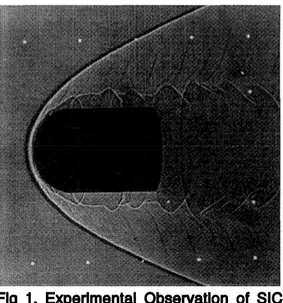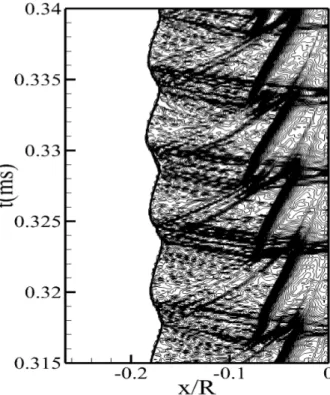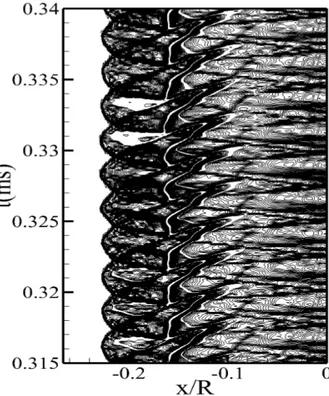Analysis of Oscillation Behaviour in Unsteady
Shock-Induced Combustion with Detailed Reaction
Mechanisms
P.Pradeep Kumar*, Kui-Soon Kim*, Sejong Oh*, Jeong-Yeol Choi*†
ABSTRACT
Unsteady Shock-Induced Combustion has been studied for the past few decades since it is considered as one of the potential ways to reach supersonic flights. Experimental observations of Unsteady SIC were observed as early as 1960‘s. But Lehr was the first to report in detail the mechanisms of Shock-Induced Combustion experimentally. Numerical Studies on SIC were helpful in explaining the insight into the oscillatory behaviour in the mid 90‘s to early 2000‘s. Detailed reaction mechanisms is required to prediction the SIC flowfield more in detail. However at that time, very few reaction mechanisms on hydrogen-oxidation were reported. In the last decade, various number of hydrogen reaction mechanisms were reported. In this study, an attempt has been made to analyze the effect of various reaction mechanisms in an unsteady mode of Shock-Induced Combustion.
Key Words : Shock-Induced Combustion, Detailed Hydrogen reaction Mechanism, Unsteady Combustion, Low Frequency Oscillation, CFD
* Pusan Nat'l Univ, Aerospace Engineering Dept † Contact Author: aerochoi@pusan.ac.kr
TEL : (051)510-3284 FAX : (051)-513-3760
Unsteady Shock-Induced Combustion has been studied for the past few decades since it is considered as one of the potential ways to reach supersonic flights. Experimental observations of Unsteady SIC were observed as early as 1960‘s. But Lehr was the first to report in detail the mechanisms of Shock-Induced Combustion experimentally. Numerical Studies on SIC were helpful in explaining the insight into the oscillatory behaviour in the mid 90‘s to early 2000‘s. It was reported for detailed reaction mechanisms is required to prediction the SIC flowfield. However at that time, very few reaction mechanisms on hydrogen-oxidation were reported. In the last decade, various number of hydrogen reaction mechanisms were reported. In this study, an attempt has been made to analyze the effect of various reaction mechanisms in an unsteady mode of Shock-Induced Combustion. Theoretically, it
helps to understand the instability problems associated with the combustion.
For this study, case of Lehr’s experiment in which a hemispherical projectile of diameter 15mm is passed into a premixed combustible mixture composing H2-Air at pressure 0.421 atm, Temperature of 292K and Mach number of about 4.48. The resultant flow field was observed to predict a uniform shock-Induced Combustion. However the experimental result also shows a varying mode of oscillation as shown in Fig.1. The experimental frequency at such flow conditions were observed as 425 Khz. Choi.et.al reported that to predict the oscillation flow in unsteady SIC flowfield, an uniform grid system of 200x300 is sufficient. Hence that grid system is used in this study throughout. The reaction mechanisms considered in this study includes GRI 3.0, University of California – San Diego (UCSD model), University of Southern California(USC model), Jachimowski model and Dryer model (Princeton University). Basic reactive properties such as Ignition Delay times and Laminar Flame Speed were compared at
Fig. 2 An Overview of the Flow features of SIC flowfield with Jachimowski’s mechanism for the case of Lehr’s Experiment with mach number of 4.48. Fig 1. Experimental Observation of SIC
flowfield at Mach 4.48.
the pressure along the stagnation point and x-t diagram along the stagnation streamline can be useful in analysing the unsteady phenomena in SIC. As shown in Fig.2, Jachimowski mechanisms predicts an uniform oscillation over a period of time. An FFT analysis shows that the period of ocillation of the projectile at mach numer 4.48 is 415 KHz. Matsuo.et.al proposed a mechanisms for the Large Disturbance Regime as shown in Fig.3. x-t graph of all the mechanism was depicted in the Fig.4 – Fig. 9. the location of shock wave, reaction front, contact discontinuity, compression wave and retonation were clearly depicted with the x-t graph with density ratio to that of the freestream density. Also the oscillation frequency of the projectile were compared.
Fig. 3 LDR mechanism proposed by Matsuo.et.al
Fig. 4 x-t diagram using Dryer mechanism
Fig. 5 x-t diagram using GRI mechanism
Fig. 6 x-t diagram using Jachimowski 1988 mechanism
Fig. 7 x-t diagram using Jachimowski 1992 mechanism
Fig. 8 x-t diagram using UCSD mechanism
Fig. 9 x-t diagram using USC mechanism
As shown in xt graphs, J88 mechanism, UCSD and USC mechanisms predict the oscillation frequency quite well, Hpwever Jachimowski 1992 mechanism shows a low frequency oscillation. similarly Dryer mechanism shows low frequency oscillation but not reflected in the x-t graph as in the pressure-time plots, while GRI mechanisms shows a different frequency oscillation than that of the experimental frequency. Induction time of GRI mechanisms at higher temperature is much higher than that of the experimental results as seen from the x-t graph. In this study, the influenct of Kinetic mechanisms on Shock-Induced Combustion has been analysed. UCSD and USC mechanisms predict SIC well compared to the other mechanisms and the effect is shown with the help of x-t graph of the density contour along the stagnation streamline.
Acknowledgement
Present work waws carried out with the support by the Space Core Technology Research Grants (NRF_2013M1A3A3A02042430) of the National Research Foundation(NRF) of Korea, funded by the Ministry of Science, IST and Future Planning(MSIP) of the Korean Government. It is also supported in part by the Advanced Research Center Program(NRF-213R1A5A1073861) of NRF funded by MSIP contracted through Advanced Space Research Center at Seoul National University.
Reference
[1] H.F. Lehr., “Experiments on Shock-Induced Combustion”, Astronautica Acta, 1972, Vol. 17, pp. 589-597.
[2] A. Matsuo, and K. Fujii., “Detailed Mechanism of the Unsteady Combustion Around Hypersonic Projectiles”, AIAA Journal,
1996. Vol. 34 No. 10 pp. 2082-2089.
[3] J.Y Choi, I.S Jeung, and Y. Yoon, " Computational Fluid Dynamics algorithms for Unsteady Shock-Induced Combustion. Part 1: Validation," AIAA. J.,2009, Vol. 38, No. 7, pp. 1179-1187
[4] J.Y Choi, I.S Jeung, and Y. Yoon, " Computational Fluid Dynamics algorithms for Unsteady Shock-Induced Combustion. Part 2: Comparison," AIAA. J.,2009, Vol. 38, No. 7, pp. 1188-1195
[5] Burke,M.P, Chaos M, Ju Y, Dryer F.L, Klippenstein S.J, "Comprehensive H2/O2 Kinetic Model for High-Pressure Combustion", Wiley Online Library, 06, December, 2011 [6] Smith GP,et.al. GRI Mech 3.0, http://
www.me.berkeley.edu/gri_mech/
[7]. Jachimowski C.J, " An Analysis of Combustion Studies in Shock Expansion Tunnels and Reflected Shock Tunnels", NASA - TP 3224, July 1992
[8] http://combustion.ucsd.edu
[9]. Davis S.G, Joshi A.V, Wang H, Egolfopoulos F, " An Optimized Kinetic Model of H2/CO Combustion", Proceedings of the Combustion Institute 30 (2005) 1283 - 1292.


